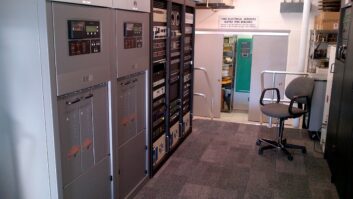
Wifi Analyzer gives quick measurement of all wireless signals in the area.
Nearly six-and-a-half years ago, when Apple released the first iPhone, I don’t think many of us would have believed that the first tool we would grab for our job was a smartphone.
Even when Google presented its first attempt nearly a year later, the thought of having 1.5 million apps available to smartphone users — on the two major platforms alone —was inconceivable for most people.
Radio World has written before about a number of useful apps; see www.radioworld.com/apps. I’d like to share some that I have found to be useful in my day-to-day work, beyond the two clearly most basic — camera and flashlight apps!
FING
Fing is my favorite must-have app. In a wireless network environment, Fing will touch every network device and provide a host of great information to you. Once it has done its scan, you can click on individual computers it found and run network scans to determine what network services are running on the machine.
Fing not only does this for LAN networks, but it can give valuable bits about IP addresses in the WAN space as well.

Lessons in Electric Circuits is divided into both primer and reference for any radio engineer.

Fing finds all of the network connected devices on a LAN.
If you administer more than one wireless network, you might be interested in an extension of Fing called Fingbox. This allows you to do remote scans of your networks, check on your TCP services and get alerts about changes in your networks. By placing the Fing software on a piece of hardware in each network (a Fing Sentinel), you can get detailed information about all of your sites from anywhere you have data cell service.
The Fing app is free and is available in both iOS and Android flavors. Fingbox is a pay-per-month (or year) service and has varying levels of features and pricing.
WIFI ANALYZER (NETWORK MULTIMETER)
Wifi Analyzer is another app that you should place on your phone immediately. Wifi Analyzer can help you determine the best place to put your Wi-Fi access point.
Once you place your access point, open up Wifi Analyzer and walk the office. It gives immediate graphical feedback, and you’ll know exactly where your Wi-Fi signal strength and weakness will be.
In the 2.4 GHz spectrum, there are only 11 channels and they overlap each other. What if a neighboring business or tenant has Wi-Fi? Wifi Analyzer will help you cut down on interference you might receive from those other Wi-Fi networks. Each signal that is detected is denoted and labeled in a different color for a quick accounting of your Wi-Fi spectrum. The app monitors the 5.8 GHz spectrum, as well with the same set of tools at your disposal.
The app is pretty well laid out. Swiping to the left or right will switch to different graphical formats that break down your Wi-Fi environment, including access to a time-sequence graph that allows you to see all of the Wi-Fi signal interactions over time.
Wifi Analyzer is free and Network Multimeter is $0.99.
BVNC FREE (REMOTERVNC)
When I use bVNC Free, I fancy myself as a drone pilot and try to remember that I can do a lot of damage from 3,000 miles away!
The ability to get into your systems remotely is empowering, especially via your phone. BVNC allows access over basic vnc, vnc over ssh, ultravnc, and several other encrypted secure VNC protocols.

Fing can determine which Web services are available at a specific IP address.

DVRs with mobile apps can help you check up on activity at the studio or transmitter sites.
On a 4- to 5-inch screen, you might imagine it difficult to navigate screens. Pinch-to-zoom helps alleviate that and gets you where you need to be on the remote screen.
The direction arrows, CTRL, ALT, TAB and ESC keys are available from a shaded area in the bottom middle of the screen. The keyboard is brought up by tapping the shaded area on the right middle of the screen. The app also allows for a “view only” mode.
The app has saved me several trips to the studio and is clearly worth the price (free). Remoter VNC is available for iOS with nearly the same feature set.
DVR CAMERA ACCESS
Speaking of remote access, it is worth noting that a number of surveillance camera DVR combinations have apps that allow for remote access. If you have network access to your sites from the studio, it is a fairly straightforward procedure to make your DVR available for remote viewing of the cameras at the tower site.
The DVR surveillance cameras at three of our sites are made by Lorex. It offers the apps for free to customers so that after only a few minutes of setup, you can see what is going on at your remote tower sites. They are availble for both iOS and Android.
ELECTRODROID
When I saw everything that the ElectroDroid Pro version had over the free version, I suffered through not having a Coke and a bag of chips for the afternoon and bought the app from the play store right then ($2.79).
The fact is that a list of everything it calculates, has pinouts for and the resources alone is exhausting — and makes it unique and worth every penny. It also has plugin availability for an electronic parts seeker, Atmicro and PICmicro databases.

Access your systems remotely by phone with bVNC.
I should mention that most apps “do” something. This app is simply an industrial electronics teacher’s collected notes and ideas after finding complete frustration in the textbooks he was given to teach.
What it “does” is teach. I fall into the category of a radio engineer who came in through the computer door, not the RF or circuitry doors. You may have similar engineers that you are mentoring. The app is broken down into DC, AC, semiconductors, digital, reference and experiments. It is available for free in the play store and for $6.99 in the iTunes store.
This list is certainly not exhaustive, but maybe you have a killer app that you use on a regular basis. Share it with me via email at [email protected].
Todd Dixon is an assistant engineer at Crawford Broadcasting’s Birmingham facility and a regular RW contributor.







